 |
| April 16, 2019 | Volume 15 Issue 15 |
Designfax weekly eMagazine
Archives
Partners
Manufacturing Center
Product Spotlight
Modern Applications News
Metalworking Ideas For
Today's Job Shops
Tooling and Production
Strategies for large
metalworking plants
World's largest airplane (and space launcher) completes first flight
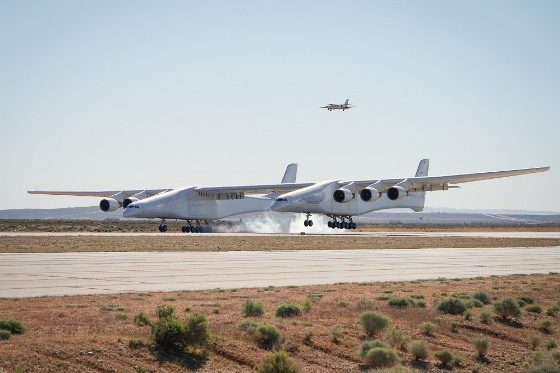
It's wider than a football field is long, and it really flies!
Stratolaunch Systems, the space company started by Microsoft co-founder Paul Allen in 2011, reached a major milestone on Saturday, April 13, when its dual-fuselage main carrier vehicle, called Stratolaunch, flew for 2.5 hours over the Mojave Desert at altitudes up to 17,000 ft on its maiden flight. The giant plane will one day launch space payloads from its unique center span while in the air.
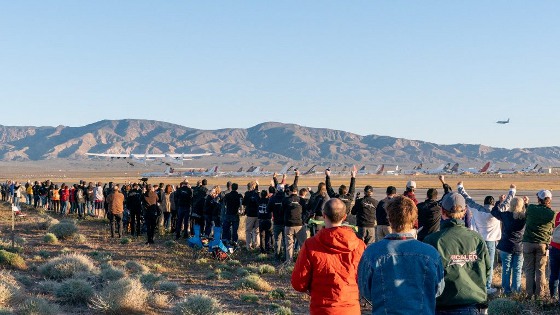
The Stratolaunch aircraft left the ground at 06:58 PDT from the Mojave Air Space Port in California.
Evan Thomas, the test pilot who flew the Stratolaunch aircraft, said at a press briefing after the event, "The flight itself was smooth, which is exactly what you want the first flight to be. And for the most part, the airplane flew as predicted, which is again exactly what we want."
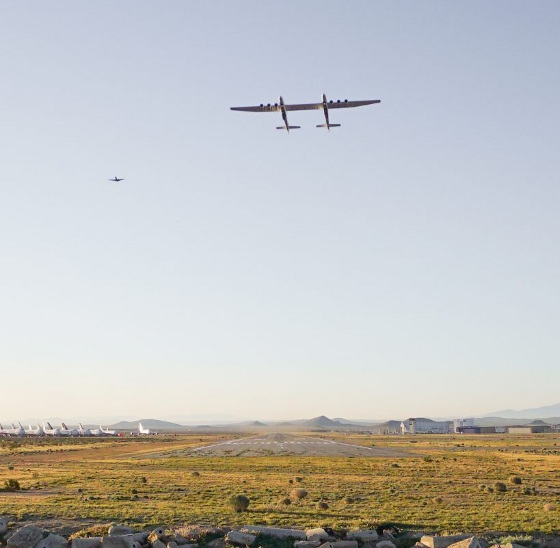
According to Stratolaunch, Thomas is a former F-16 pilot. During his 28 years in the U.S. Air Force, he held a variety of positions including Vice Wing Commander 46th Test Wing as well as Director of Operations, NATO Combined Air Operations Center 5. Most recently, Thomas was Senior Test Pilot at Calspan Corporation for seven years and has been a test pilot at Scaled Composites since January 2018. Evan specializes in experimental flight test, aviation and test safety, aircraft stability, and control testing, as well as operational leadership.
The vehicle achieved a maximum speed of 189 mph. It is powered by six Boeing 747 Pratt & Whitney PW4056 engines.
The Stratolaunch aircraft is designed solely to be a mobile launch platform that will enable convenient, affordable, and routine "airline-style access" to space. The hallmark of the design is the reinforced center wing, which can support multiple launch vehicles -- weighing up to a total of 500,000 lb. The wingspan, the largest of any plane ever assembled, is 385 ft.
The plane features two cockpits, one on each side of the massive launch-bay space, but only one is used at any given time to fly the craft. Future rocket-driven payloads will be released after the plane reaches a cruising altitude of 35,000 ft.
One of the system's biggest benefits is that the company does not have to maintain a traditional rocket spaceport on the ground. Also, runway takeoffs can circumvent bad weather more often, as well as air traffic and other variables that cause delays with traditional ground launches.
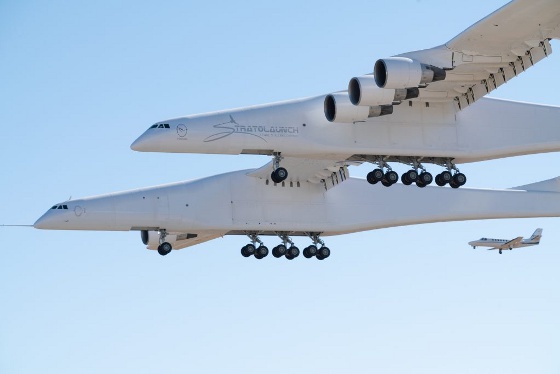
Last August, the company announced the family of launch vehicles that will carry satellites to multiple orbits and inclinations on a single mission. The aim is to enter regular service starting in 2020.
The launch vehicles include: Pegasus (815-lb/370-kg payload for a single or triple configuration); the Medium Launch Vehicle (MLV), optimized for short satellite integration timelines (7,495-lb/3,400-kg payload); the Medium Launch Vehicle Heavy, a three-core MLV variant with capability to deploy heavier payloads to orbit (13,227-lb/6,000-kg payload); and a Space Plane, a fully reusable vehicle that enables advanced in-orbit capabilities and cargo return, with initial designs optimized for cargo launch but a follow-on variant capable of transporting crew (payload not provided). The smallest launch vehicle, Pegasus, has already been tested with more than 35 successful launches.
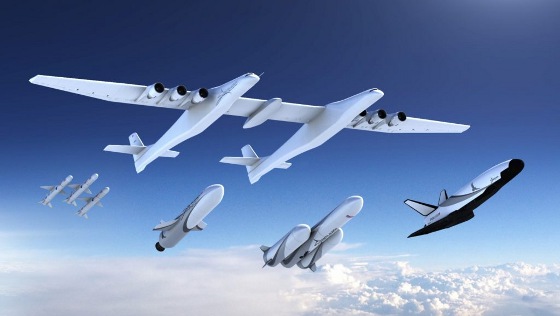
The Stratolaunch test team conducted standard aircraft testing exercises, including:
- Performed a variety of flight control maneuvers to calibrate speed and test flight control systems, including roll doublets, yawing maneuvers, pushovers and pull-ups, and steady heading side slips, and
- Conducted simulated landing approach exercises at a max altitude of 15,000 ft mean sea level.
"We got running down the runway, did our rotation, and the airplane very nicely and smoothly rotated," said Thomas at the press recap. "It really just lifted off the ground and definitely was ready to fly and wanted to fly. It climbed out quickly, and that was great to see. Then we turned out and basically went right into our test cards, climbing up to 15,000. For the first part of the flight, we checked out the handling qualities of the aircraft, which again, it flew very much like we had simulated and predicted, which is exactly what we want."
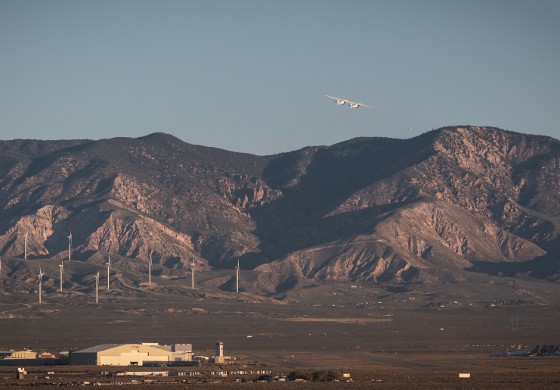
"We saw a few little things that were off nominal, but really for a first flight, it was spot on," continued Thomas. "We checked out the handling qualities, they all looked pretty good. Our air data system was really close, and that was very nice. We brought down the flaps, and then we repeated our handling qualities, taking a look at what it was going to be like to land, checking the pitch response of the airplane, and then practicing some rolls and yaws to make sure we'd be able to line up with the runway like we wanted to. That all felt pretty good.
"The systems on the airplane ran like a watch. It is a very complex airplane -- the propulsion, the pneumatic system, the hydraulics; they all ran perfectly, which was great. We were able to concentrate on practicing some simulated approaches and getting ready to come back to land. The simulated approaches all felt good, up and away. So then we came in, lined up at the Mojave Air and Spaceport. Flew sort of a turnaround towards Edwards Air Force Base and lined up on a nice long final. Came in for a low approach. Everything seemed good on the low approach, so then we came back around, flew another nice long final. Saw that plenty of folks had come out today to watch us land and went for the landing.
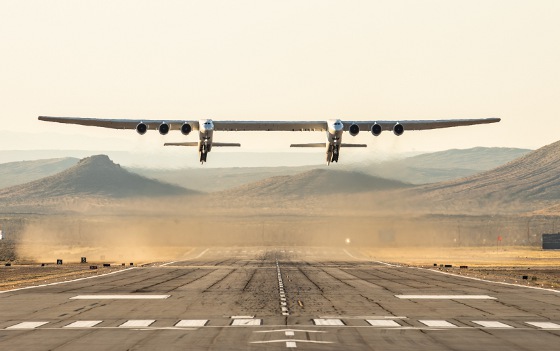
"Then we came in, touching down pretty much where we wanted to on speed. The airplane felt really nice on the touchdown, gear felt good. We had a couple of corrections to line up in the slow-down and ended up rolling to a stop pretty much where we wanted to coming off the runway, so it was overall fantastic.
"I honestly could not have hoped for more on a first flight, especially of an airplane of this complexity and this uniqueness," said Thomas.
VIDEO: Stratolaunch first flight.
Unfortunately, the person who started it all was not there to witness the historic first flight. Paul Allen passed away at age 65 in October 2018.
"We all know Paul would have been proud to witness today's historic achievement," said Jody Allen, Chair of Vulcan Inc. and Trustee of the Paul G. Allen Trust (and also Paul Allen's sister). "The aircraft is a remarkable engineering achievement, and we congratulate everyone involved."
Source: Stratolaunch Systems
Published April 2019
Rate this article
View our terms of use and privacy policy
